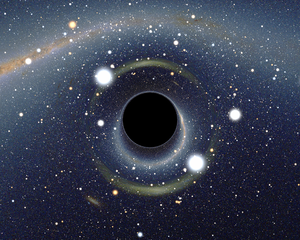A black hole, according to the general theory of relativity, is a region of space from which nothing, including light, can escape. It is the result of the deformation of spacetime caused by a very compact mass. Around a black hole there is an undetectable surface which marks the point of no return, called an event horizon. It is called "black" because it absorbs all the light that hits it, reflecting nothing, just like a perfect black body in thermodynamics. nder the theory of quantum mechanics black holes possess a temperature and emit Hawking radiation.


Black holes are the evolutionary endpoints of stars at least 10 to 15 times as massive as the Sun. If a star that massive or larger undergoes a supernova explosion, it may leave behind a fairly massive burned out stellar remnant. With no outward forces to oppose gravitational forces, the remnant will collapse in on itself. The star eventually collapses to the point of zero volume and infinite density, creating what is known as a " singularity ". Around the singularity is a region where the force of gravity is so strong that not even light can escape. Thus, no information can reach us from this region. It is therefore called a black hole, and its surface is called the " event horizon ".
No comments:
Post a Comment
Note: Only a member of this blog may post a comment.